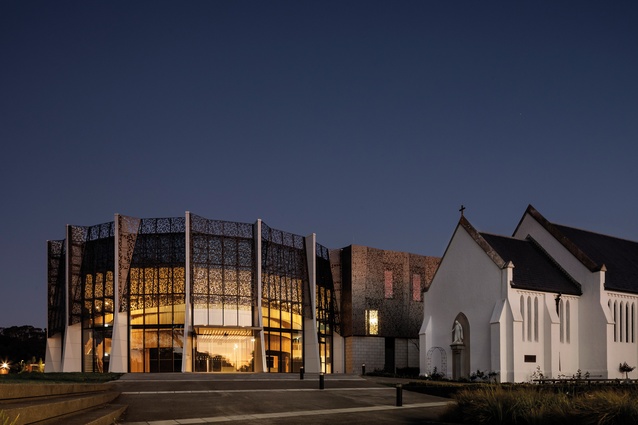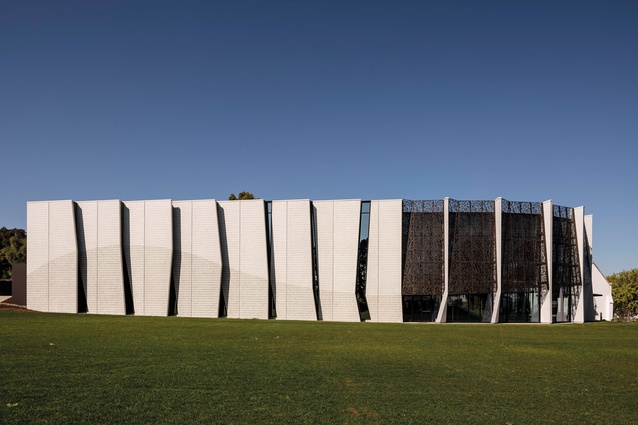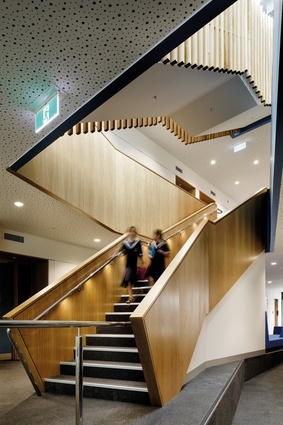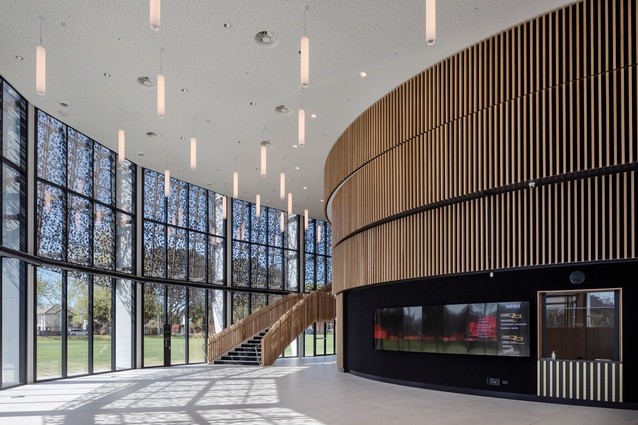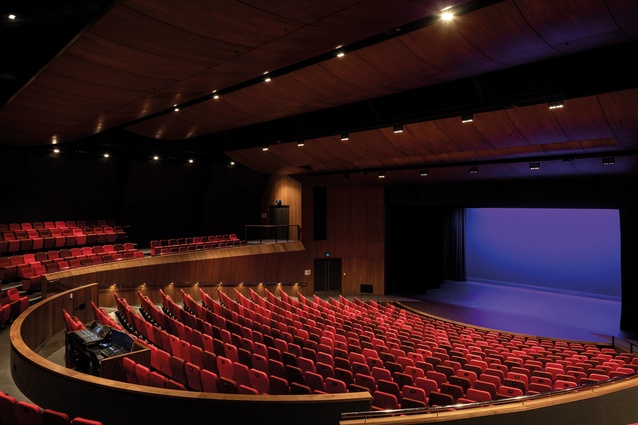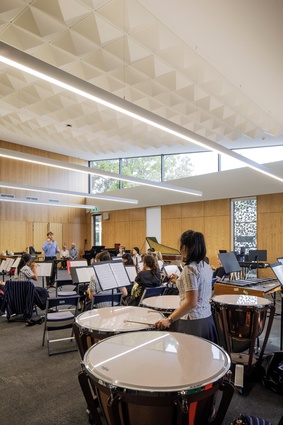Shaping a richer culture
Dorita Hannah explores Diocesan School for Girls’ basilica-like Performing Arts Centre by McIldowie Partners in association with Upton Architects and what it highlights about the value of theatre in Auckland Tāmaki Makaurau.
[Editor’s note: This article was written prior to the most recent COVID-19 restrictions being imposed across Aotearoa that began in August 2021.]
Theatres are distinctive cultural buildings that assemble large groups of people within a single room to share a live event. And this ‘liveness’ defines the experience on both sides of the conventional divide between stage and auditorium. The performance itself is directly affected by the dynamic energy specific to the unique character of each audience, establishing a reciprocal exchange that can be found in sports arenas, band venues and celebrations such as weddings and funerals. Yet, over the last 18 months, we have seen this event dimension threatened by a global pandemic, where proxemic bodies signal imminent danger; such gatherings have been curtailed at the expense of communal entertainment, professional livelihoods, and sociocultural ceremonies. Recent cancellation of shows, suspension of festivals and temporary closures of venues serve to remind us of the performing arts paradox, whereby their precarity within a market-driven economy is countered by the vital role they play in platforming cultural expression and harnessing collective dynamism.
So, the June 2021 opening of a new performing arts centre in Tāmaki Makaurau bodes well for the future of theatre as both art form and built form in Aotearoa New Zealand. Boasting an auditorium of 920 seats arranged in curvilinear rows embraced by timber walls, the building features a light-filled foyer, rehearsal rooms, practice spaces and state-of-the-art technology. Yet, this basilica-like venue – sited on the crest of a greenfield site and signalling its nocturnal presence via internal lighting that permeates a filigreed screen façade – is a highly specced education facility designed for Diocesan School for Girls in Epsom’s leafy neighbourhood.
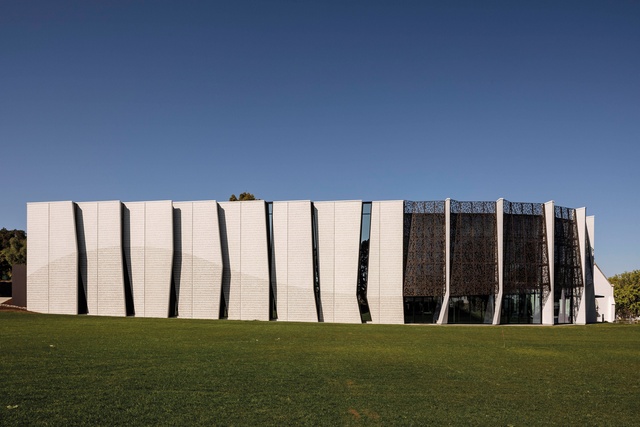
Developed by local architect Graham Upton with Melbourne-based firm McIldowie Partners, who worked in close collaboration with the school’s performing arts department, this auditorium crowns the centre, which was established on site with teaching facilities in 2017. Completing the five-stage campus master plan, formulated and essentially realised by the same team since 2005, the facility represents the school’s commitment to drama, dance and music by siting these activities within a singular complex where they can inform one another. Making way for such integration – even though each discipline remains independently taught – is fitting in an age where the lines between art forms are increasingly blurred, and siloed disciplines are becoming less relevant.
The centre is testimony to Diocesan’s recognition of the ability of creative curricula to nurture development in other subjects and increase both intellectual and emotional quotients. This is best illustrated when experiencing the building in performance mode: by day, as a bustling performing arts academy, with utilisation of all practice and rehearsal rooms; and, at night, through an activated foyer and auditorium, already booked out for the rest of the year.
In June, I was fortunate to attend the school’s yearly ‘Night of Dance’ event, in which 200 girls presented a two-hour programme of routines: leaping, sashaying, tangoing and popping on the boards of their new theatre alongside kapa haka presentations and Samoan Sasa. They took to the stage with joy and confidence, while almost a thousand friends and family applauded and whooped from the auditorium, with especially boisterous ovations for the hip-hop crews. It was clear that this venue is successfully designed for assemblies, lectures, musicals, rock quests, stage challenges, proscenium theatre and other frontal modes of presentation.
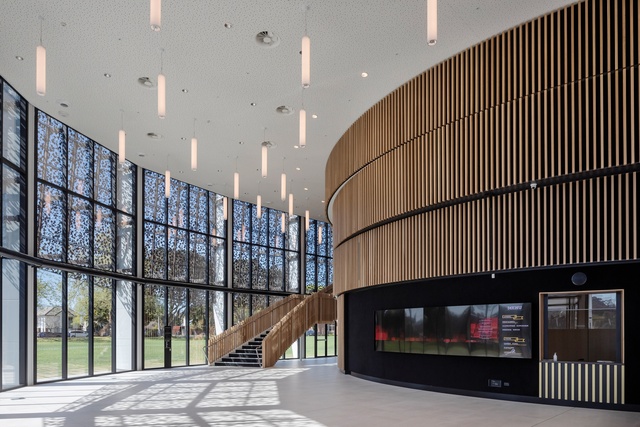
However, I couldn’t help wondering what kind of space would be ideal for Māori and Pasifika performance, as well as hip hop and more-experimental hybrid forms that challenge the raised, framed stage. Despite the school’s fulsome accommodation brief, earlier specialist consultation could have challenged some expectations and encouraged flexible spatial models, seen in contemporary performance practices, such as immersive, intermedial, object and multi-format theatre. While the intimacy that is missing can be found by adapting rehearsal rooms and the school hall for smaller productions, more experimental spaces can contribute to shaping future interdisciplinary practices and presentations. The foyer itself provides a large-enough location for minor performance events, with its glazed wall already utilised as a backdrop for sunset concerts.
The overall architecture itself is capacious, with the high theatre foyer adjoining a central, multilevel, light-filled atrium, which features a robust timber staircase and enigmatically moulded forms for students to occupy between scheduled classes. Dedicated rooms are acoustically shaped with appropriate materials and finishes, including an isolating base for the percussion studio. This attention to specialised requirements, especially for music, has resulted in unique practice rooms, including choral and recording studios, with successful input by Marshall Day Acoustics, who have achieved an auditory balance between music and spoken word in the auditorium. The main issue with planning lies in siting the stage towards, rather than away from, the foyer. This results in no rear truck dock, with drop-off access limited to the north field, where doors adjoining a foyer corridor link to the stage. Direct access is also limited between the stage and generous back-of-house facilities that are sited on the floor above. However, this amplitude is compromised with only two dedicated dressing rooms adjacent to the green room, which forms an overflow dressing space for large productions, as do the rehearsal rooms below. Turning the auditorium 180 degrees would have also created a more-layered foyer with overlooking galleries that would take advantage of the lobby’s height. Such walkways can be found in the initial 2014 sketch design, which included a multilevel auditorium with sunken orchestra pit; unfortunately, these aspects were value-engineered away.
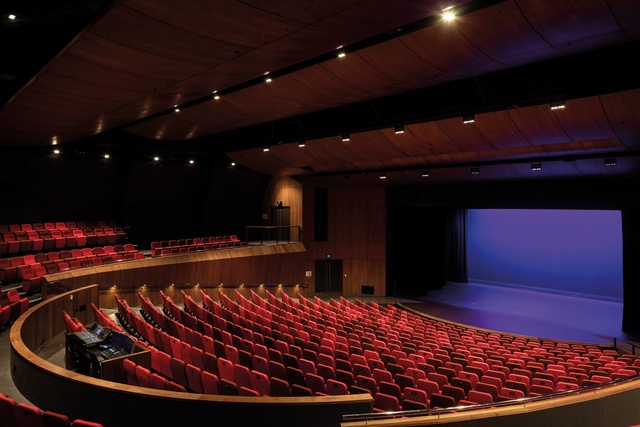
While the robust detailing serves the daily traffic of a fully functioning school facility, more finessed spatialities and finishing could have established intimate moments within the overall architecture as event. In fact, the spatial generosity in both foyer and auditorium tends to withhold this sense of proximity that is necessary for creating a more immediate relationship and experience between performers and audience as well as between spectators themselves. Such finer-grained intimacy can, however, be found in the exterior courtyards created by the relationship of the overall performing arts centre to adjacent spaces. The building’s exterior treatment also attends to minimising the monumentality that such a large auditorium can generate through material layering and detailing.
Perforated aluminium screens feature a foliage pattern, adapted from a student illustration, signifying the onsite oaks that define many colonial church and education campuses in Auckland. Filtering light into the foyer by day, these tessellated panels directly refer to a tree canopy and, in the evening, internal lighting emphasises their provision of a lacy mantle that softens and moderates what would otherwise be a monolithic form. They fold over a series of white-cement concrete walls, imprinted with shapes of tiny leaves, which are angled to let light into the foyer wrapping the horseshoe-shaped auditorium. Giving a whole new meaning to tilt-slab construction, the slanting uprights resist pure verticality, subtly tilting in and out to create a sense of movement. These twisting pale slabs and bronze screens complement the walls and roofs of the adjoining Chapel of Saint Barnabas, built 150 years earlier (and moved onto the site in 1910), which continues to form the heart of this Anglican campus.
One can’t help but recall the role of theatres in the late 19th and early 20th centuries as new cathedrals to culture in an increasingly secular world, which, occupying central urban sites, continue to signal a metropolitan commitment to the arts. Yet New Zealand has tended to undervalue its performing arts venues, as stated in 2016 by art critic Hamish Keith, who tweeted: “What is the Auckland disease that drives it to attack and destroy theatres – relentless, endless”.
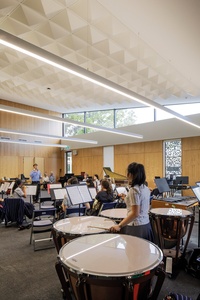
Keith was responding to the unceremonious demolition of Warren and Mahoney’s Maidment Theatre by the University of Auckland. His lament is haunted by the prior demolition of His Majesty’s Theatre (1987), closure of the Mercury Theatre (1992) and mothballing of the St James Theatre (2007): all significant historic venues, seating between 700 and 1700 people, which would be lovingly restored, preserved and protected in most countries where the performing arts thrive as highly valued forms of cultural expression. The destruction of Sir Miles Warren’s brutalist 1976 masterpiece was a major loss to both professional and academic performance communities of Auckland, despite the more-recent openings of Q Theatre (2011), Te Pou Theatre (2015) and the ASB Waterfront Theatre (2016).
And therein, as Shakespeare’s Hamlet claimed, ‘lies the rub’: not as a flaw in Diocesan School for Girls’ performing arts facilities but as an inherent shortcoming in venues currently offered by the tertiary sector. The University of Auckland has failed to replace the accommodation required for its programmes in dance, drama and music, which was lost when it destroyed the Maidment five years ago. In fact, no other education campus in New Zealand can boast the range and quality of spaces offered by Diocesan, although Wellington’s Te Whaea National Dance and Drama Centre does come close.
It is up to the overall education sector to be inspired by Diocesan’s commitment to the performing arts; this is especially so for universities, which seem intent on building recreation and sports centres in lieu of theatres. What this new stand-alone venue demonstrates is a commitment to the performing arts, which inspire future dancers, actors, musicians, technicians, scenographers, directors, stage managers and producers. It is also significant for audiences as well as communities who value ‘liveness’ and what the arts bring to shaping a richer culture beyond market value.

